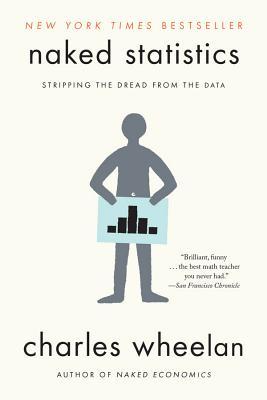Review: Charles Wheelan’s “Naked Statistics”
by Miles Raymer

Charles Wheelan’s Naked Statistics provides a serviceable summary of a field most people don’t properly understand and often misinterpret. “The paradox of statistics,” Wheelan writes, “is that they are everywhere––from batting averages to presidential polls––but the discipline itself has a reputation for being uninteresting and inaccessible” (xii). He makes a spirited though imperfect effort to resolve this paradox by giving readers the basic tools to analyze the types of statistics that are most common in our everyday lives.
As someone who took AP Statistics in high school and isn’t exactly innumerate, it was humbling to realize that my knowledge of this important and ubiquitous aspect of modernity was badly in need of a refresher. But a refresher isn’t very useful without an effective way to solidify information in memory, and this is where Naked Statistics really shines. Wheelan has a talent for metaphor and simile, which he readily applies to statistical concepts in a way that makes them much easier to remember and critically apply. Here are my favorite examples:
Statistics can be overly accessible, in the sense that anyone with data and a computer can do sophisticated statistical procedures with a few keystrokes. The problem is that if the data are poor, or if the statistical techniques are used improperly, the conclusions can be wildly misleading and even potentially dangerous…Statistics is like a high-caliber weapon: helpful when used correctly and potentially disastrous in the wrong hands. (xiv, emphasis his)
A “statistically significant” finding…means that the analysis has uncovered an association between two variables that is not likely to be the product of chance alone. For academic researchers, this kind of statistical finding is the “smoking gun.” (11)
Statistical analysis is…like good detective work…Smart and honest people will often disagree about what the data are trying to tell us. (14)
Descriptive statistics can be like online dating profiles: technically accurate and yet pretty darn misleading. (17)
Statistical arguments have much in common with bad marriages; the disputants often talk past one another. (38)
Probability offers a powerful and useful set of tools––many of which can be employed correctly to understand the world or incorrectly to wreak havoc on it. In sticking with the “statistics as a powerful weapon” metaphor that I’ve used throughout the book, I will paraphrase the gun rights lobby: Probability doesn’t make mistakes; people using probability make mistakes. (100)
Data are to statistics what a good offensive line is to a star quarterback. In front of every star quarterback is a good group of blockers. They usually don’t get much credit. But without them, you won’t ever see a star quarterback. (111)
The mechanics of regression analysis are not the hard part; the hard part is determining which variables ought to be considered in the analysis and how that can best be done. Regression analysis is like one of those fancy power tools. It is relatively easy to use, but hard to use well––and potentially dangerous when used improperly. (187)
Wheelan’s “statistics as a powerful weapon” metaphor is on target, as are the other figurative tactics deployed in Naked Statistics. One might argue that likening statistics to weaponry is somewhat hyperbolic, but Wheelan provides convincing evidence that statistics can be extremely harmful when used improperly––in some cases much more harmful than actual weapons, albeit less directly. Wheelan also makes a lot of jokes along the way to lighten the mood.
One significant shortcoming of the book is that Wheelan doesn’t give any information about Bayesian statistics, instead focusing solely on the traditional Frequentist models. It would have been good to get at least one chapter addressing this topic, but Bayesian theory doesn’t receive even a single mention in the index.
Another problem is that, by no fault of Wheelan’s, certain aspects of Naked Statistics haven’t aged well since 2013. The conclusion, which identifies five socially significant questions that statistics can help answer, has a section on poverty but includes no mention of basic income, cash transfer programs, negative income tax, or any of the other proposals currently being advanced to solve this massive problem. In another section on privacy, worries about Facebook take up barely more than a paragraph. It’s hard to know how up-to-date or not these perspectives would have seemed when the book was originally published, but in the 2020s they seem a bit quaint and underdeveloped.
One less forgivable misstep is Wheelan’s omission of climate change from the list of global problems in which statistics plays a critical role. Apparently the future of football deserves a couple pages, but not the imminent human-caused catastrophe that will dominate human attention for decades and perhaps centuries to come. Climate change was inarguably a major issue in 2013, so perhaps Wheelan didn’t want to touch a controversial topic. But, especially in retrospect, it seems a dereliction of duty to write a book like this and not include anything about how statistics contributes to our understanding of ecosystems around the world or its role in constructing the climate models that forecast the possible consequences of our (in)action.
Fortunately, Wheelan’s final message hasn’t aged a day:
Statistics is more important than ever before because we have more meaningful opportunities to make use of data. Yet the formulas will not tell us which uses of data are appropriate and which are not. Math cannot supplant judgment. (255)
Rating: 4/10